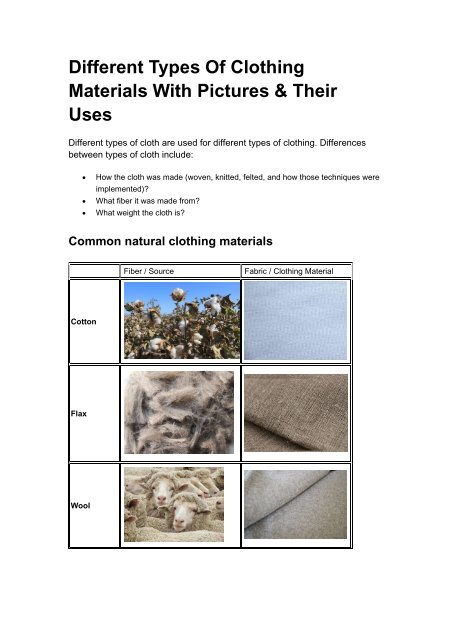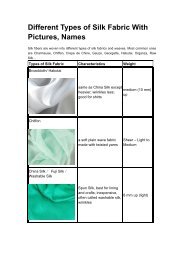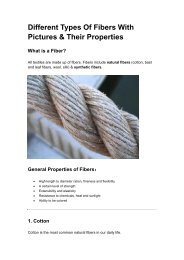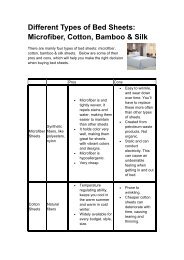Different Types Of Clothing Materials With Pictures
Different Types Of Clothing Materials With Pictures https://www.pandasilk.com/faqs/
Different Types Of Clothing Materials With Pictures
https://www.pandasilk.com/faqs/
You also want an ePaper? Increase the reach of your titles
YUMPU automatically turns print PDFs into web optimized ePapers that Google loves.
<strong>Different</strong> <strong>Types</strong> <strong>Of</strong> <strong>Clothing</strong><br />
<strong>Materials</strong> <strong>With</strong> <strong>Pictures</strong> & Their<br />
Uses<br />
<strong>Different</strong> types of cloth are used for different types of clothing. Differences<br />
between types of cloth include:<br />
• How the cloth was made (woven, knitted, felted, and how those techniques were<br />
implemented)?<br />
• What fiber it was made from?<br />
• What weight the cloth is?<br />
Common natural clothing materials<br />
Fiber / Source<br />
Fabric / <strong>Clothing</strong> Material<br />
Cotton<br />
Flax<br />
Wool
Ramie<br />
Silk<br />
Denim<br />
Leather<br />
Down For<br />
Down-Filled<br />
Parkas<br />
Fur
Common synthetic clothing materials<br />
Some clothing is made from synthetic fibers, which are man made, primarily<br />
from petrochemicals. Common man-made materials include:<br />
Nylon<br />
Polyester<br />
Spandex<br />
• Nylon was first produced in 1935. Nylon is a thermoplastic silky material. It<br />
became famous when used in women’s stockings (“nylons”) in 1940. It was<br />
intended to be a synthetic replacement for silk and substituted for it in many<br />
different products after silk became scarce during World War II.<br />
• Polyesters include naturally occurring chemicals and synthetics. Natural<br />
polyesters and a few synthetic ones are biodegradable, but most synthetic<br />
polyesters are not. Polyesters may change shape after the application of heat<br />
and are combustible at high temperatures. They tend to shrink away from flames<br />
and self-extinguish upon ignition. Polyester fibers have high tenacity and E-<br />
modulus as well as low water absorption and minimal shrinkage in comparison<br />
with other industrial fibers.<br />
• Spandex (elastane) is known for its exceptional elasticity. It is stronger and more<br />
durable than rubber, its major non-synthetic competitor. It was invented in 1959<br />
by Charles Lewis French Jr. and Taylor.
Source:<br />
https://www.pandasilk.com/different-types-of-clothing-materials-with-pictures-their-uses/







